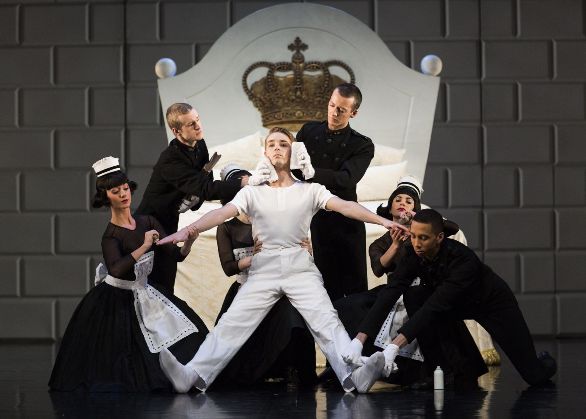Nothing thrills quite like transgression. The violation of boundaries is enough to catch one’s attention, holding it demands something more. Approaching a classic work in any genre, with an eye toward re-vision, the immediate temptation to go rogue and scribble that moustache on the Mona Lisa postcard. Alas, that’s been done too, and with panache, becoming a cultural icon in its own right. If yesterday’s rebellion is today’s conformism, what is it about certain works that retains that initial frisson of wrong-doing, the taste of that first bite?

Choose your cultural icons well might be the first bit of advice – the more potent the original, the more powerful will be the impact of the revolt, or the reverberations of the response. Composed in 1875 by Tchaikovsky, with the new choreography by Marius Petipa and Lev Ivanov from the 1895 revival, Swan Lake has achieved such stature over time that it has become a popular culture stand-in for ballet itself. It’s the go-to ballet reference. Just ask Barbie.
Swan Lake exerts a power over the contemporary imagination through its invocation of timeless questions: good and evil, beauty, identity and sexuality, especially in relation to constancy and change; appearance and essence. The swan in nature enfolds within it the concept of changing identity, expressed in the simplest and poetic manner in Hans Christian Anderson’s tale of The Ugly Duckling (1843) as the plain brown furry creature grows into the elegant, white bird he had admired from afar. The ballet takes the concept of transformation in a different direction, enhancing the aura of mystery and transgressive aspects of the tale. Not only has Odette been changed into a swan by the evil sorcerer Von Rothbart, but she is doubly betrayed as the evil Odile takes on the appearance of Odette to fool Prince Siegfried into pledging his love.
Tchaikovsky’s music and Petipa’s choreography have an enduring beauty, I am unabashed to say that Swan Lake remains one of my favorite ballets. Yet its influence extends beyond the concert hall and the world of dance. Swan Lake has become an emblem of beauty, and the cultural implications are worth reflection and examination. In its choreography and imagery, Swan Lake creates an ideal of beauty, grace and femininity that imposes a certain definition and equivalence on these qualities, uniting them in a deadly trinity. Deadly? Yes, just follow the storyline: perfect, pure and beautiful though she is, it does not end well for Odette. Culturally, Swan Lake perpetuates a certain paradigm of what a ballet dancer ought to be, one that even contemporary dancers are not entirely free to leave behind, and by extension, a paradigm of the ideal woman: delicate, slender, fragile.
Artistic responses to issues of beauty, femininity and sexuality in Swan Lake have resulted in a range of meaningful expressions. Natalie Portman’s internal struggle in Darren Aronofsky’s thriller Black Swan (2010) takes a a darker look at these issues, and yet I find the Muppet Show version more transgressive as it plays with the taboos of ballet. Miss Piggy’s duet with Rudolf Nureyev (The Muppet Show, Season Two, 1977) is an amusing parody that would seem to internalize the prevailing Swan Lake paradigm in an unquestioning manner. Nureyev is horrified by the appearance of his dance partner, and the audience is invited to share in his shock and disdain. When he tries to get rid of her, literally throws her away, it’s not supposed to be disturbing, it’s funny. After all, everybody knows: fat girls can’t dance. Yet, Miss Piggy is so oblivious to this slight, and seems only aware of her own joy in dancing, that once cannot help but read a subversive message in this simple spoof. No matter what he does, she keeps coming back to perform. She is there to take the final bow and applause of the audience, and that is a kind of triumph and critique.
Matthew Bourne’s Swan Lake enters boldly into the arena, to tell a different story from a different perspective, while challenging some cherished illusions. If the ideal dancer, and ideal woman, is beautiful, delicate and graceful, the question to ask becomes: why do we insist on thinking of the dancer as a woman? And, perhaps even more puzzling, why does our culture persist in equating beauty with goodness?

Premiering in 1995, this ballet set up the prince as the main protagonist, offering a post-Freudian look at his character and circumstances, with fresh, sassy costuming and choreography. The radical move of this work is not merely in casting men as the swans, Bourne re-imagines the swans and their role in the ballet, creating a reflection and critique on our concepts and cultural norms of nature, gender roles and beauty.

Having seen Bourne’s Swan Lake years ago, I remember watching this playful and daring production with delight. The scenes with the swans are fascinating in their duality: at once beautiful and challenging traditional concepts of beauty, evoking and rebelling against the images of the classical Swan Lake. In its creative audacity, wit and bold grappling with issues that remain open and controversial, Bourne’s Swan Lake touches the very essence of our emotions and sense of identity, with a wild and graceful transgressive turn.
Matthew Bourne’s Swan Lake will be performed at the Israeli Opera from June 3 – 14, 2014. Dates and times of performances are listed on the Israeli Opera website and tickets may be purchased online.





